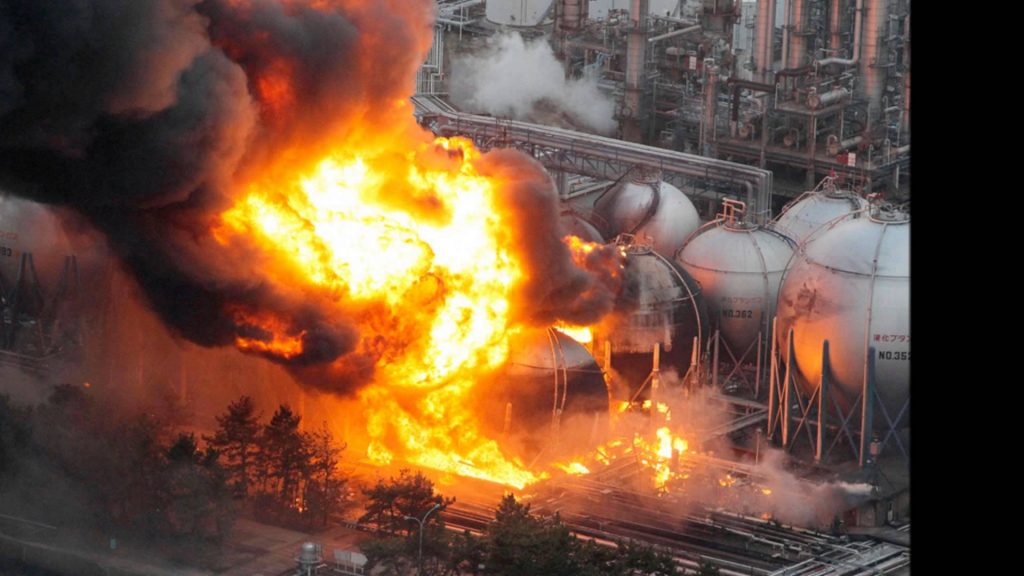Natural disasters are very common but tragic events around the world. From earthquakes to tornadoes, geological disasters can cause increasingly damaging effects, affecting the landscape and those who find themselves there. But when these events are combined with man-made artifacts, the effects might be even greater. An example of this is the Fukushima Disaster in Japan, the worst nuclear disaster since the 1986 Chernobyl incident.1 But the cause of this horrific disaster wasn’t particularly a man-made event. In fact, it all started with a wave.

On March 11, 2011, an earthquake with a magnitude 9.0—the worst to ever hit Japan—hit the country. It was such a powerful catastrophe, that Japan’s main island, Honshu, was permanently moved more than two meters to the east. As the earthquake gained momentum, waves up to 40 meters began crushing the country’s coast. The effects of the earthquake and the waves were too much for the Japanese. More than 20,000 people died or went missing and hundreds of thousands more lost their homes.2 But the worst was yet to come. Fifty minutes after the initial earthquake, a ten-meter high sea wall hit the Fukushima Daiichi (Number One) nuclear power plant. The water flooded the plant’s emergency power generators, knocking vital cooling systems offline, triggering a meltdown of reactor fuel rods. These then leaked deadly radiation into the coastal atmosphere of Japan. With the cooling systems not working, hydrogen gas built up in the reactor buildings, causing several hydrogen explosions in the following days of the earthquake.3

Because of the highly toxic radioactive material that leaked to the surrounding areas of the power plant, the government began to evacuate 80,000 people from a twelve-mile radius. Technicians turned to several things to try to cool the nuclear fuel, like using fresh water, seawater, and injecting nitrogen into the reactor containment buildings to prevent further explosions.4 But despite the efforts to try to help the people of Honshu, the government didn’t tell the people the truth. The official statistics of the event and even the admittance that the meltdown had taken place weren’t disclosed until eighty-eight days later.5
It was estimated that more than 800,000 tons of highly-radioactive material sat near the accident, which was slowly getting into the ground and moving towards the ocean. Although many people were evacuated, there were still many that couldn’t leave. The government installed temporary housing that was intended to house tens of thousands of people after the disaster for twenty-four months. But five years after the disaster, thousands of people were still living where they were surrounded by the radioactive material. Many of those who remained were the elderly and low-income families who had few options to move away.6

Several months after the disaster, people in other parts of Japan began rallying to help these people and bring an end to nuclear power plants in Japan. This pushed forward for the closure of all of the other nuclear plants in Japan for maintenance and inspection.7 These protests also pressured the government to issue a report on the disaster at Fukushima. This report criticized TEPCO (the Tokyo Electric and Power Company) for failing to address concerns about safeguards at the plant. This report also included information about how TEPCO officials had ignored engineers’ concerns that a seawall constructed to protect against major tsunamis as they had seen on March 11 was not sufficient. The report additionally criticized safety regulators for not implementing proper safety measures and for failing to adopt global nuclear safety standards.8 This was really important for the Japanese because TEPCO had always emphasized that the nuclear generators were “fail-safe,” that the facility was completely earthquake resistant and that the reactors would be able to withstand a major tremor.9
Five years after the disaster in Japan, several policies were changed to address the rising concerns of the Japanese population regarding nuclear power plants. The major decision of this kind was the decision to phase-out nuclear power plants during the 2030s as part of Innovative Strategy for Energy and the Environment adopted by the cabinet of the Democratic Party of Japan (DPJ).10 TEPCO is still facing criticism regarding the amount of nuclear material that was leaked into the environment and it is estimated that cleanup operations could take up to forty years.11
- Will Ripley, Junko Ogura, and James Griffiths, “Fukushima: Five Years after Japan’s Worst Nuclear Disaster,” CNN, March 11, 2016, sec. World. ↵
- Encyclopedia Britannica, 2018, s.v. “Fukushima Accident.” ↵
- New World Encyclopedia, 2017, s.v. “Fukushima nuclear disaster.” ↵
- New World Encyclopedia, 2017, s.v. “Fukushima nuclear disaster.” ↵
- Will Ripley, Junko Ogura, and James Griffiths, “Fukushima: Five Years after Japan’s Worst Nuclear Disaster,” CNN, March 11, 2016, sec. World. ↵
- Will Ripley, Junko Ogura, and James Griffiths, “Fukushima: Five Years after Japan’s Worst Nuclear Disaster,” CNN, March 11, 2016, sec. World. ↵
- New World Encyclopedia, 2017, s.v. “Fukushima nuclear disaster,” ↵
- Encyclopedia Britannica, 2018, s.v. “Fukushima Accident.” ↵
- Akira Nakamura and Masao Kikuchi. “What We Know, and What We Have Not Yet Learned: Triple Disasters and the Fukushima Nuclear Fiasco in Japan,” Public Administration Review 71, no. 6 (2011): 894. ↵
- Rie Watanabe, “After the Fukushima Disaster: Japan’s Nuclear Policy Change from 2011 to 2012,” Review Of Policy Research 33, no. 6 (2016): 623. ↵
- Alexis Dudden, “The Ongoing Disaster,” The Journal of Asian Studies 71, no. 2 (2012): 349. ↵




111 comments
Courtney Reeves
I remember vividly watching the news that day, covering that story live. I watched water and large amounts of debris crash into houses and large buildings, picking them up and causing more destruction along the way. The amount of damage that was caused by the earthquake, which was the largest recorded earthquake in Japan, and the tsunami combined totalled out to hundreds of billions of dollars in damage. Also, it’s insane to think that there is still debris floating around in the ocean from that particular event.
Courtney Reeves
I remember vividly watching the news that day, covering that story live. I watched water and large amounts of debris crash into houses and large buildings, picking them up and causing more destruction along the way. The amount of damage that was caused by the earthquake, which was the largest recorded earthquake in Japan, and the tsunami combined totalled out to hundreds of billions of dollars in damage.
Cynthia Perez
How could they let it get that bad though? I mean yeah, businesses mostly care about their efficient reputations rather than the affects they have on the environment. It’s a massive shame to see how they’d still try to protect themselves after being partially responsible for the toxic pollution they had produced and exposed to the people surrounding it. However they had it contained at first and the reason for it being released is by a natural disaster. I feel as if they had addressed the problem too soon there could’ve been a mass public outrage and panic that could’ve also harmed them and created more damage to their economy.
Jose Chaman
Incredible story, I have heard about this disaster many times, but I never thought that the greatest actor in the development of the nuclear failure was the earthquake.The way in which the Japanese government responded was too slow, it could be compared (in that way) to the Chernobyl disaster, as the Soviet government prolonged the mobilization of civilians and concealed from them the dangers of staying there. I really liked this article!
Kristina Tijerina
Lately I’ve been reading up on scientists not clearly stating the effects of any testing done on people, and the Fukushima Disaster is the same. The government waited eighty-eight days to disclose information about the meltdown that occurred. And although they tried to get as many people as they could to safety, there were many others left over who didn’t have an option to leave. I think it was good that the people in Japan started to rally about the highly radioactive equipment that was present. It shouldn’t have been present in the first place when destructions that are estimated to take up to forty years to clean up like this can occur.
Vania Gonzalez
Major events like these really make you think about what we are doing to our planet because we have things (nuclear power) that we can not control if it were to get out of hand. A lot of the times any explosion like this that has to do with our power happens out of natural causes and there is no way we can control the environment surrounding us. It is incredible to think that even after five years it is still continuing to affect Japan today and that even after that tragedy they still continue to use those type of power plants.
Eliezer Leal
It pains me to see how ignorant people can be at times, especially if its for greed or just laziness. Not long ago I read an article with the same situation, dangerous and sensitive technology with flaws that if overlooked can cost lives. Companies hire employees because they trust them to know what their job is, but to hire them and not listen to what they know is fact is ridiculous. People need to stop costing lives for simple mistakes and see past their own egos and listen to reason.
Kasandra Ramirez Ferrer
I have never heard of the Fukushima disaster but it does surprises for how it affected the Japnese population with the death of so many people and the ones who lost their homes. I think that the Japanese government should not have hidden the truth from its citizens and shouldn’t have taken so much time to respond with the information for them. It saddens me every time I hear about the number of lives these massive natural disasters take and how it affects the lives of many people.
Jose De Julian
I actually know about the Fukushima Disaster as I did a presentation about Chernobyl,Fukushima, and 3 Mile Island. These are 3 of the worst Nuclear Disasters. Exposure to radiation is highly dangerous and could cause cancer and DNA mutations. Although the disaster wasn’t human error I can’t understand why the Japanese government didn’t release information to it citizens sooner. Nuclear disasters are horrible and the government should have released information as soon as possible.
Cassandra Sanchez
I have heard of this happening but I didn’t know the details of the event and how it all happened. I think it is terrifying how the government kept this important information hidden from the people. I know in this situation I would want to know exactly what is going on because these chemicals can be harmful to myself and others.